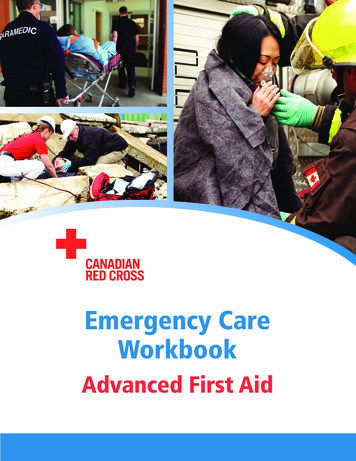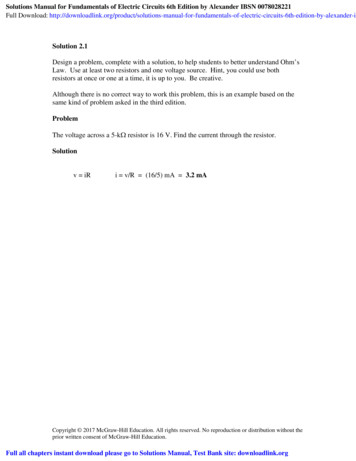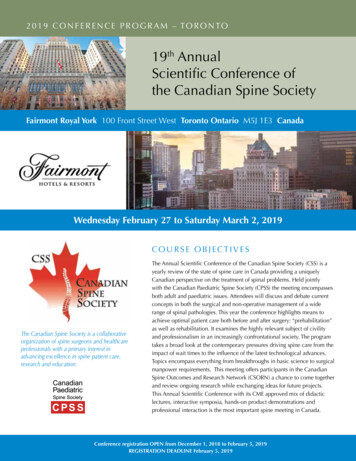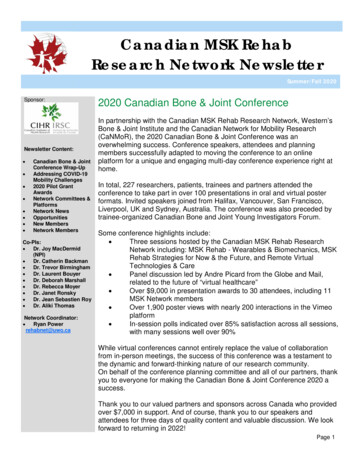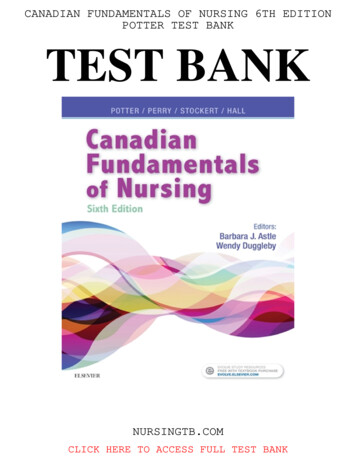
Transcription
CANADIAN FUNDAMENTALS OF NURSING 6TH EDITIONPOTTER TEST BANKTEST BANKNURSINGTB.COMCLICK HERE TO ACCESS FULL TEST BANK
NCLEX 02.pdfCPNRE 02.pdf
Canadian Fundamentals of Nursing 6th Edition Potter Test BankChapter 02: The Canadian Health Care Delivery SystemPotter et al: Canadian Fundamentals of Nursing, 6th EditionMULTIPLE CHOICE1. What is the fastest growing component of the health care system?a. Primary care.b. Respite care.c. Home care.d. Palliative care.ANS: CCanadian health care is shifting from an institution-based system to one in which communitycare is playing a greater role. Home care is one of the fastest growing components of thehealth care system, partly because patients are sent home from hospital sooner than they usedto be. Primary care, respite care, and palliative care are not the fastest growing components ofthe health care system.DIF: ApplyREF: 27OBJ: Describe five levels of health care and associated types of services.TOP: Assessment MSC: NCLEX: Health Promotion and Maintenance2. Which of the following is a contributing factor to the shortage of nurses in Canada?a. Increased birth rate, which creates a greater demand for nursing services.b. New technology, which replaces nurses at the bedside.c. Fewer people wishing to practise as nurses because health trends are focusing onNURSINGTB.COMnatural and alternative therapies.d. Retirement of a large percentage of nurses.ANS: DThe nursing workforce is currently challenged by the aging of workers, high retirement rates,ethical problems in international recruitment, and lack of full-time positions. The average ageof registered nurses in Canada is 44.6 years. The aging of the population is creating thegreater demand for nursing services. Neither the replacement of nurses at the bedside by newtechnology nor the focus of health trends on natural and alternative therapies is a factoridentified as contributing to the shortage of nurses.DIF: ApplyREF: 19 (Box 2-1)OBJ: Discuss principal factors influencing health care reform and the current health care deliverysystem.TOP: PlanningMSC: NCLEX: Safe and Effective Care Environment3. A nurse working with a group of Indigenous parents refers to Treaty 6, which includes aprovision for health care services and is often referred to asa. The Truth and Reconciliation Actb. The “medicine chest” clause.c. The Indigenous band agreements.d. The land and relationship understanding.ANS: BNURSINGTB.COM
Canadian Fundamentals of Nursing 6th Edition Potter Test BankTreaty 6 was often referred to as the “medicine chest” clause, as it included a provision forhealth care services to be provided to Indigenous communities. The Indian Act, theIndigenous band agreements (signed with the British government before Confederation), andland and relationship agreements do not refer to Treaty 6.DIF: Understand REF: 20OBJ: Identify initiatives related to enhancing quality of the Canadian health care delivery system.TOP: PlanningMSC: NCLEX: Health Promotion and Maintenance4. Which of the following is an example of a true health promotion service provided by a nurse?a. An immunization clinic.b. A diabetic support group.c. A prenatal nutrition class.d. A smoking cessation clinic.ANS: CCommunity clinics offer prenatal nutrition classes that promote the health of the woman,fetus, and infant. Building healthy public policy, creating supportive environments,strengthening community action, developing personal skills, and reorienting health servicesare part of health promotion service. An immunization clinic is an example of disease andinjury prevention. A diabetic support group may be an example of a rehabilitation service, tohelp patients adapt to a change in lifestyle. A smoking cessation clinic may be offered as partof a rehabilitation service or as a disease and injury prevention intervention.DIF: ApplyREF: 28OBJ: Describe five levels of health care and associated types of services.TOP: ImplementationMSC: NCLEX: Health Promotion and MaintenanceNURSINGTB.COM5. When conducting a health care system class for immigrants to Canada, the nurse informs themthat the federal government is responsible for which of the following?a. Providing health care insurance plans.b. Managing and planning insurable health services.c. Delivering health care services to targeted groups.d. Providing long-term care services.ANS: CThe federal government is charged with delivering, or co-delivering, health care services fortargeted groups. Health care insurance plans, managing and planning insurable healthservices, and providing long-term care services are the jurisdiction of the provinces orterritories.DIF: ApplyREF: 22OBJ: Identify and define the principles of the Canada Health Act and significant legislation related tothe Canadian health care system.TOP: ImplementationMSC: NCLEX: Health Promotion and Maintenance6. The nurse initiated a support group for adolescent parents and is teaching them aboutchlorinated water and child immunizations, which are all examples of which of the following?a. Health promotion.b. Disease and injury prevention.c. Supportive care.NURSINGTB.COM
Canadian Fundamentals of Nursing 6th Edition Potter Test Bankd. Rehabilitation.ANS: BDisease and injury prevention includes illness prevention (chlorinated water, immunizations)and support groups. Health promotion services include antismoking services, advocacy forhealthy public policy, and provision of wellness services. Supportive care describes servicesprovided over a prolonged period to people who are disabled, who have never been able tofunction independently, or who have a terminal disease. Rehabilitation, such as physiotherapy,involves restoring optimal health.DIF: ApplyREF: 28OBJ: Describe five levels of health care and associated types of services.TOP: ImplementationMSC: NCLEX: Health Promotion and Maintenance7. Primary care is best described as what?a. Early detection and routine care, as well as prevention.b. Provision of a specialized medical service.c. Treatment of all patients with a minimum level of health insurance.d. Provision of medical services in a patient’s home.ANS: APrimary care is the first contact of a patient with the health care system that leads to a decisionregarding a course of action to resolve any actual or potential health problem. The focus is onearly detection and routine care, with emphasis on education to prevent recurrences. Provisionof a specialized medical service by a specialist or through referral is an example of secondarycare. No patient is refused treatment on the basis of level of insurance. Medical servicesprovided in the patient’s home, although not very common, could be categorized underprimary care but would not bestdescribeNURMSINGprimaryTB.COcare.DIF: Understand REF: 28OBJ: Identify various settings and models of care delivery in the Canadian health care deliverysystem.TOP: Assessment MSC: NCLEX: Health Promotion and Maintenance8. A patient comes to the ambulatory care clinic for management of a chronic condition and asksthe nurse for an explanation of the Medicare system. The nurse’s response is based on theknowledge that it isa. Canada’s national health insurance system.b. A fee-for-service insurance plan.c. A plan in which monies from provincial taxes are used for nursing homes.d. A social insurance program for low-income earners.ANS: AMedicare is a key element of Canada’s social safety net. It is Canada’s national healthinsurance system, in which taxes are used to finance medically necessary services for allcitizens, thus providing “free” health care to all. Medicare is not a fee-for-service insuranceplan, a plan in which monies from provincial taxes are used for nursing homes, or a socialinsurance program for low-income earners.DIF: Understand REF: 19OBJ: Discuss the evolution of Canada's social safety net and Medicare.TOP: ImplementationMSC: NCLEX: Health Promotion and MaintenanceNURSINGTB.COM
Canadian Fundamentals of Nursing 6th Edition Potter Test Bank9. In teaching a group of older persons about health care spending, a nurse tells them that about14% of the Canadian population is in their age group and that this group accounts for whatpercentage of health care spending?a. 25%.b. 35%.c. 45%.d. 55%.ANS: COlder persons account for 45% of health care spending in Canada, not 25, not 35, and not55%.DIF: ApplyREF: 22OBJ: Discuss principal factors influencing health care reform and the current health care deliverysystem.TOP: ImplementationMSC: NCLEX: Health Promotion and Maintenance10. To whom do the principles of the Canada Health Act of 1984 apply?a. Members of the Canadian Armed Forces.b. Insured residents of Canada.c. Inmates of federal penitentiaries.d. Royal Canadian Mounted Police (RCMP).ANS: BThe principles of the Canada Health Act apply to all insured residents of Canada (i.e., eligibleresidents) but exclude members of the Canadian Armed Forces, Royal Canadian MountedPolice (RCMP), eligible veterans, inmates of federal penitentiaries, and some refugeeclaimants.N R I G B.C MU S N TODIF: Understand REF: 20OBJ: Identify and define the principles of the Canada Health Act and significant legislation related tothe Canadian health care system.TOP: AssessmentMSC: NCLEX: Health Promotion and Maintenance11. When a mother brings her child to be seen in a nurse-managed setting, over concerns that herchild’s rash could be measles, what type of care is rendered?a. Respite care.b. Primary care.c. Supportive care.d. Secondary care.ANS: BPrimary care focuses on early detection and routine care, and can be offered in nurse-managedclinics. Respite care is a component of supportive care. Supportive care describes servicesprovided to disabled and terminally ill patients over a prolonged time period. Secondary careis the provision of specialized medical services by a physician specialist or through referralfrom a primary care provider.DIF: Understand REF: 28OBJ: Describe five levels of health care and associated types of services.TOP: Assessment MSC: NCLEX: Health Promotion and MaintenanceNURSINGTB.COM
Canadian Fundamentals of Nursing 6th Edition Potter Test Bank12. Which of the following is one of the four pillars of primary health care, as described by theNational Primary Health Care Awareness Strategy (2006)?a. Teams.b. Universality.c. Health promotion.d. Immediate access to primary care.ANS: ATeams are one of the four pillars, along with access, information, and healthy living. The fourpillars do not include universality, health promotion, or immediate access to primary healthcare.DIF: Understand REF: 25 (Box 2-3)OBJ: Identify various settings and models of care delivery in the Canadian health care deliverysystem.TOP: PlanningMSC: NCLEX: Health Promotion and Maintenance13. Mr. Jones is 72 years old. He is ambulatory and is to be discharged from hospital after a totalhip replacement, with requirements for daily physiotherapy and respiratory therapy. What isthe most appropriate facility referral for the nurse to make?a. A rehabilitation centre.b. An assisted-living facility.c. A community health clinic.d. A home care agency.ANS: DA home care agency provides health services to individuals and families in their homes. Homecare was created to provide individualized care for people after hospital discharge but hasincreasingly included patientsNinages fromINGofTB.CURa SrangeOM very young to very old; those withmental, physical, or developmental challenges; and those requiring recovery to end-stage care.A rehabilitation centre is not required, as Mr. Jones is ambulatory. Assisted-living facilitiesare community-based residential facilities in which adults live in their own apartments and areprovided with a range of support services such as meals, social and recreational programs, andlaundry. A community health clinic is the first point of contact, offering a range of primaryservices that emphasize prevention, health promotion, health education, communitydevelopment, and partnerships to develop a healthy local community.DIF: ApplyREF: 26 27OBJ: Identify various settings and models of care delivery in the Canadian health care deliverysystem.TOP: ImplementationMSC: NCLEX: Health Promotion and Maintenance14. What is an appropriate referral for an older patient who requires some assistance with dailyactivities within a partially protective environment?a. Respite care.b. Rehabilitative care.c. Assisted living.d. Extended care.ANS: CNURSINGTB.COM
Canadian Fundamentals of Nursing 6th Edition Potter Test BankSuch a patient requires assisted living. Assisted living allows adults to receive a range ofsupport services, including personalized assistance in achieving a level of independence.Personal assistance services are “designed to promote maximum dignity and independence,”including meal preparation, personal hygiene practice, mobility, and socialization. Respitecare is a service that provides short-term relief for family caregivers or persons providinghome care to the ill or disabled. Rehabilitative care provides therapy and training, with thegoal of decreasing the patient’s dependence on care. An extended, or long-term, care facilityprovides intermediate medical, nursing, or custodial care for patients recovering from acute orchronic illness or disabilities.DIF: ApplyREF: 26 27OBJ: Identify various settings and models of care delivery in the Canadian health care deliverysystem.TOP: ImplementationMSC: NCLEX: Health Promotion and Maintenance15. The Canadian Patient Safety Institute (CPSI) provides leadership in building and advancing asafer health care system. According to the CPSI, about two thirds of preventable incidents thatoccur during hospitalization are related to what?a. Procedures.b. Care or medication.c. Patient accidents.d. Infection control.ANS: BAccording to the CPSI, about two thirds of preventable events are either care related ormedication related. About one third of the events are related to procedures or patientaccidents. Infections fall under the category of care.NURSINGTB.COMDIF: RememberREF: 30OBJ: Discuss principal factors influencing health care reform and the current health care deliverysystem.TOP: PlanningMSC: NCLEX: Health Promotion and Maintenance16. “Residents temporarily absent from their home province are to have their incurred servicespaid for by the home province, in the same amount that would have been paid by the homeprovince.” This statement reflects which principle of the Canada Health Act (1984)?a. Portability.b. Universality.c. Public administration.d. Accessibility.ANS: AThis statement describes the principle of portability. The principle of universality means that100% of the insured persons of a province are covered by the health care plan. The principleof public administration means that the health care plan must be administered and operated ona nonprofit basis by a public authority, responsible to the provincial government and subjectto audits of its accounts and financing transactions. The principle of accessibility means thatthe health care plan of a province must provide for (1) insured health services and reasonableaccess by insured persons; (2) reasonable compensation of physicians and dentists for allinsured services rendered; and (3) payments to hospitals in regard to the cost of insured healthservices.NURSINGTB.COM
Canadian Fundamentals of Nursing 6th Edition Potter Test BankDIF: Understand REF: 21 (Table 2-1)OBJ: Identify and define the principles of the Canada Health Act and significant legislation related tothe Canadian health care system.TOP: PlanningMSC: NCLEX: Health Promotion and MaintenanceMULTIPLE RESPONSE1. Canadian health care workers’ rights include which of the following? (Select all that apply.)a. Reasonable working conditions.b. To refuse dangerous work.c. To receive appropriate compensation.d. Access to proactive measures.e. Access to their own health care information.ANS: A, B, DCanadian health care workers’ rights include the right to reasonable working conditions;absence of discrimination, abuse, and harassment of any type; the right to refuse dangerouswork; and access to proactive measures (such as personal protective equipment). Receivingappropriate compensation and access to their own health care information are not included inCanadian health care workers’ rights.DIF: Understand REF: 23OBJ: Discuss multiple roles and challenges for all categories of regulated nurses in different healthcare settings.TOP: ImplementationMSC: NCLEX: Health Promotion and Maintenance2. A Canadian is explaining to a non-Canadian friend the benefits of the Canadian health careNURGTB.CSINableOM surgical or medical hospital-based caresystem. The Canadian discussesbeingto accesswith no out-of-pocket charges; mentions that if he or she must travel for work to anotherprovince within Canada, he or she is still covered; and explains that it is easy to access healthcare services and that the care received is respectful and embraces diversity. Which of thefollowing principles of the Canada Health Act of 1984 is the Canadian describing? (Select allthat apply.)a. Public administration.b. Comprehensiveness.c. Universality.d. Portability.e. Accessibility.f. Protection.ANS: B, C, D, EThe principles described by the Canadian include comprehensiveness, universality,portability, and accessibility. The ability to access surgical or medical hospital-based carewith no out-of-pocket charges refers to comprehensiveness; the ability to reasonably accesshealth care services refers to accessibility; and respectful care that embraces diversity refers touniversality. Portability refers to the ability to access healthcare services in another province.Public administration is another principle of the Canadian Health Act but is not described bythe Canadian. Protection is not a principle of the Canadian Health Act.DIF: ApplyREF: 21OBJ: Identify and define the principles of the Canada Health Act and significant legislation related toNURSINGTB.COM
Canadian Fundamentals of Nursing 6th Edition Potter Test Bankthe Canadian health care system.TOP: AssessmentMSC: NCLEX: Health Promotion and MaintenanceNURSINGTB.COMNURSINGTB.COM
Canadian Fundamentals of Nursing 6th Edition Potter Test BankChapter 02: The Canadian Health Care Delivery SystemPotter et al: Canadian Fundamentals of Nursing, 6th EditionMULTIPLE CHOICE1. What is the fastest growing component of the health care system?a. Primary care.b. Respite care.c. Home care.d. Palliative care.ANS: CCanadian health care is shifting from an institution-based system to one in which communitycare is playing a greater role. Home care is one of the fastest growing components of thehealth care system, partly because patients are sent home from hospital sooner than they usedto be. Primary care, respite care, and palliative care are not the fastest growing components ofthe health care system.DIF: ApplyREF: 27OBJ: Describe five levels of health care and associated types of services.TOP: Assessment MSC: CPNRE: Foundations of Practice2. Which of the following is a contributing factor to the shortage of nurses in Canada?a. Increased birth rate, which creates a greater demand for nursing services.b. New technology, which replaces nurses at the bedside.c. Fewer people wishing to practise as nurses because health trends are focusing onNURSINGTB.COMnatural and alternative therapies.d. Retirement of a large percentage of nurses.ANS: DThe nursing workforce is currently challenged by the aging of workers, high retirement rates,ethical problems in international recruitment, and lack of full-time positions. The average ageof RNs in Canada is 44.6 years; for LPNs, it is 41, and for RPNs, it is 46. The agingpopulation is creating the greater demand for nursing services. Neither the replacement ofnurses at the bedside by new technology nor the focus of health trends on natural andalternative therapies is a factor identified as contributing to the shortage of nurses.DIF: ApplyREF: 19, Box 2-1OBJ: Discuss principal factors influencing health care reform and the current health care deliverysystem.TOP: PlanningMSC: CPNRE: Foundations of Practice3. A nurse working with a group of Indigenous parents refers to Treaty 6, which includes aprovision for health care services and is often referred to as which of the following?a. The Truth and Reconciliation Act.b. The “medicine chest” clause.c. The Indigenous band agreements.d. The land and relationship understanding.ANS: BNURSINGTB.COM
Canadian Fundamentals of Nursing 6th Edition Potter Test BankTreaty 6 was often referred to as the “medicine chest” clause, as it included a provision forhealth care services to be provided to Indigenous communities. The Indian Act, the Indianband agreements (signed with the British government before Confederation), and relationshipagreements do not refer to Treaty 6.DIF: Understand REF: 20OBJ: Identify initiatives related to enhancing quality of the Canadian health care delivery system.TOP: PlanningMSC: CPNRE: Foundations of Practice4. Which of the following is an example of a true health promotion service provided by a nurse?a. An immunization clinic.b. A diabetic support group.c. A prenatal nutrition class.d. A smoking cessation clinic.ANS: CCommunity clinics offer prenatal nutrition classes that promote the health of the woman,fetus, and infant. Building healthy public policy, creating supportive environments,strengthening community action, developing personal skills, and reorienting health servicesare part of health promotion service. An immunization clinic is an example of disease andinjury prevention. A diabetic support group may be an example of a rehabilitation service, tohelp patients adapt to a change in lifestyle. A smoking cessation clinic may be offered as partof a rehabilitation service or as a disease and injury prevention intervention.DIF: ApplyREF: 28OBJ: Describe five levels of health care and associated types of services.TOP: ImplementationMSC: CPNRE: Foundations of PracticeNURSINGTB.COM5. When conducting a health care system class for immigrants to Canada, the nurse informs themthat the federal government is responsible for which of the following?a. Providing health care insurance plans.b. Managing and planning insurable health services.c. Delivering health services to targeted groups.d. Providing long-term care services.ANS: CThe federal government is charged with delivering, or co-delivering, health care services fortargeted groups. Health care insurance plans, managing and planning insurable healthservices, and providing long-term care services are the jurisdiction of the provinces orterritories.DIF: ApplyREF: 22OBJ: Identify and define the principles of the Canada Health Act and significant legislation related tothe Canadian health care system.TOP: ImplementationMSC: CPNRE: Foundations of Practice6. The nurse initiated a support group for adolescent parents and is teaching them aboutchlorinated water and child immunizations, which are all examples of which of the following?a. Health promotion.b. Disease and injury prevention.c. Supportive care.NURSINGTB.COM
Canadian Fundamentals of Nursing 6th Edition Potter Test Bankd. Rehabilitation.ANS: BDisease and injury prevention includes illness prevention (chlorinated water, immunizations)and support groups. Health promotion services include antismoking services, advocacy forhealthy public policy, and provision of wellness services. Supportive care describes servicesprovided over a prolonged period to people who are disabled, who have never been able tofunction independently, or who have a terminal disease. Rehabilitation, such as physiotherapy,involves restoring optimal health.DIF: ApplyREF: 28OBJ: Describe five levels of health care and associated types of services.TOP: ImplementationMSC: CPNRE: Foundations of Practice7. Primary care is best described as which of the following?a. Early detection and routine care, as well as prevention.b. Provision of a specialized medical service.c. Treatment of all patients with a minimum level of health insurance.d. Provision of medical services in a patient’s home.ANS: APrimary care is the first contact of a patient with the health care system that leads to a decisionregarding a course of action to resolve any actual or potential health problem. The focus is onearly detection and routine care, with emphasis on education to prevent recurrences. Provisionof a specialized medical service by a specialist or through referral is an example of secondarycare. No patient is refused treatment on the basis of level of insurance. Medical servicesprovided in the patient’s home, although not very common, could be categorized underprimary care but would not bestdescribeNURMSINGprimaryTB.COcare.DIF: Understand REF: 28OBJ: Identify various settings and models of care delivery in the Canadian health care deliverysystem.TOP: Assessment MSC: CPNRE: Foundations of Practice8. A patient comes to the ambulatory care clinic for management of a chronic condition and asksthe nurse for an explanation of the Medicare system. The nurse’s response is based on theknowledge that it is which of the following?a. Canada’s national health insurance system.b. A fee-for-service insurance plan.c. A plan in which monies from provincial taxes are used for nursing homes.d. A social insurance program for low-income earners.ANS: AMedicare is a key element of Canada’s social safety net. It is Canada’s national healthinsurance system, in which taxes are used to finance medically necessary services for allcitizens, thus providing “free” health care to all. Medicare is not a fee-for-service insuranceplan, a plan in which monies from provincial taxes are used for nursing homes, or a socialinsurance program for low-income earners.DIF: Understand REF: 19OBJ: Discuss the evolution of Canada's social safety net and Medicare.TOP: ImplementationMSC: CPNRE: Foundations of PracticeNURSINGTB.COM
Canadian Fundamentals of Nursing 6th Edition Potter Test Bank9. In teaching a group of older persons about health care spending, a nurse tells them that about14% of the Canadian population is within their age group and that this group accounts forwhat percentage of health care spending?a. 25%.b. 35%.c. 45%.d. 55%.ANS: COlder persons account for 45% of health care spending in Canada, not 25%, not 35%, and not55%.DIF: ApplyREF: 22OBJ: Discuss principal factors influencing health care reform and the current health care deliverysystem.TOP: ImplementationMSC: CPNRE: Foundations of Practice10. To whom do the principles of the Canada Health Act of 1984 apply?a. Members of the Canadian Armed Forces.b. Insured residents of Canada.c. Inmates of federal penitentiaries.d. Royal Canadian Mounted Police (RCMP).ANS: BThe principles of the Canada Health Act apply to all insured residents of Canada (i.e., eligibleresidents) but exclude members of the Canadian Armed Forces, Royal Canadian MountedPolice (RCMP), eligible veterans, inmates of federal penitentiaries, and some refugeeclaimants.N R I G B.C MU S N TODIF: Understand REF: 20OBJ: Identify and define the principles of the Canada Health Act and significant legislation related tothe Canadian health care system.TOP: AssessmentMSC: CPNRE: Foundations of Practice11. When a mother brings her child to be seen in a nurse-managed setting, over concerns that herchild’s rash could be measles, what type of care is rendered?a. Respite care.b. Primary care.c. Supportive care.d. Secondary care.ANS: BPrimary care focuses on early detection and routine care and can be offered in nurse-managedclinics. Respite care is a component of supportive care. Supportive care describes servicesprovided to disabled and terminally ill patients over a prolonged time period. Secondary careis the provision of specialized medical services by a physician specialist or through referralfrom a primary care provider.DIF: Understand REF: 28OBJ: Describe five levels of health care and associated types of services.TOP: Assessment MSC: CPNRE: Foundations of PracticeNURSINGTB.COM
Canadian Fundamentals of Nursing 6th Edition Potter Test Bank12. Which of the following is one of the four pillars of primary health care, as described by theNational Primary Health Care Awareness Strategy (2006)?a. Teams.b. Universality.c. Health promotion.d. Immediate access to primary care.ANS: ATeams are one of the four pillars, along with access, information, and healthy living. The fourpillars do not include universality, health promotion, or immediate access to primary healthcare.DIF: Understand REF: 25, Box 2-3OBJ: Identify various settings and models of care delivery in the Canadian health care deliverysystem.TOP: PlanningMSC: CPNRE: Foundations of Practice13. Mr. Jones is 72 years old. He is ambulatory and is to be discharged from hospital after a totalhip replacement, with requirements for daily physiotherapy and respiratory therapy. What isthe most appropriate facility referral for the nurse to make?a. A rehabilitation centre.b. An assisted-living facility.c. A community health clinic.d. A home care agency.ANS: DA home care agency provides health services to individuals and families in their homes. Homecare was created to provide individualized care for people after hospital discharge but hasincreasingly included patientsNinages fromINGofTB.CURa SrangeOM very young to very old; those withmental, physical, or developmental challenges; and those requiring recovery to end-stage care.A rehabilitation centre is not required, as Mr. Jones is ambulatory. Assisted-living facilitiesare community-based residential facilities in which adults live in their own apartments and areprovided with a range of support services such as meals, social and recreational programs, andlaundry A community health clinic is the first point of contact, offering a range of primaryservices that emphasize prevention, health promotion, health education, communitydevelopment, and partnerships to develop a healthy local community.DIF:
citizens, thus providing “free” health care to all. Medicare is not a fee-for-service insurance plan, a plan in which monies from provincial taxes are used for nursing homes, or a social . Canadian Fundamentals of Nursing 6th Edition Potter Test Bank. NURSINGTB.COM Canadian Funda


